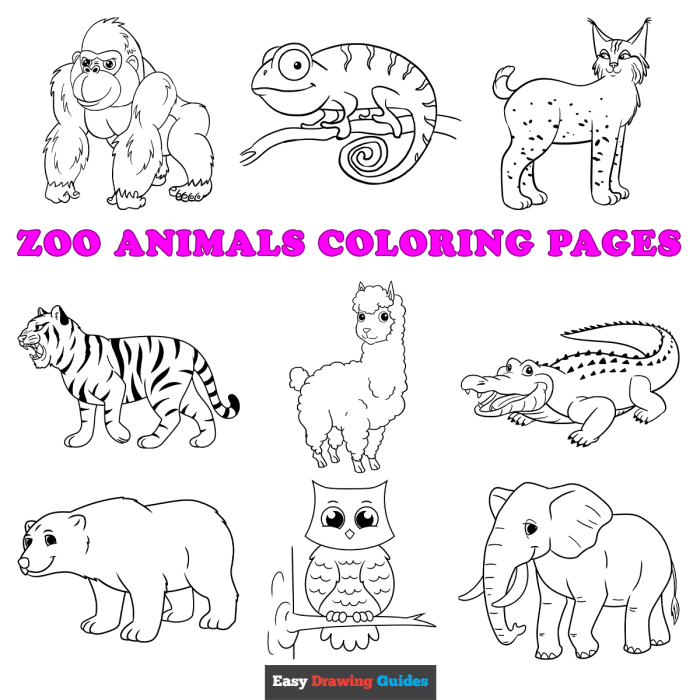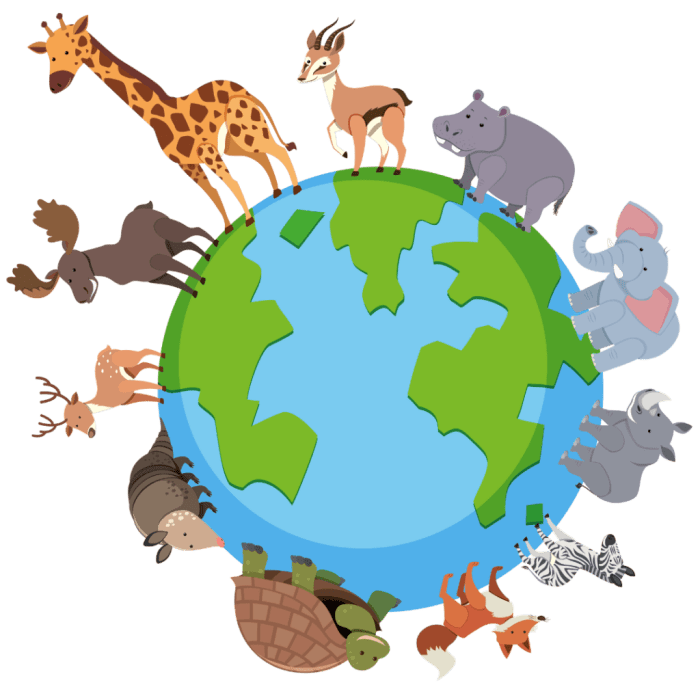Market Research

Coloring book animals printable – Understanding the market for printable animal coloring books requires a detailed look at the target audience, their motivations, and the prevailing trends in animal themes. This research will inform the design and marketing strategies for a successful product launch. The following analysis examines key aspects of the market to determine optimal product development and positioning.
Target Audience Demographics
The primary users of printable animal coloring books span a broad age range, primarily encompassing children and adults who appreciate creative expression and relaxation. Children, particularly those aged 2 to 8 years old, represent a significant portion of the market, driven by their natural inclination towards coloring and artistic exploration. However, the therapeutic benefits of coloring have also fueled a growing adult market, encompassing individuals seeking stress relief, mindfulness activities, and creative outlets.
This broader appeal significantly expands the potential customer base.
Purchasing Motivations
The motivations behind purchasing printable animal coloring books are multifaceted. For parents and caregivers, educational benefits often take center stage. Coloring enhances fine motor skills, hand-eye coordination, and color recognition in young children. Entertainment is another key driver, offering a fun and engaging activity for children and adults alike. Moreover, the therapeutic value of coloring is increasingly recognized, leading to its adoption as a stress-reduction technique and a tool for mindfulness.
The market also caters to individuals seeking creative expression or nostalgic activities.
Market Share of Animal Themes
Analyzing the market share of different animal themes reveals diverse preferences. Farm animals, such as cows, pigs, and sheep, consistently hold a significant share, particularly appealing to younger children due to their familiarity and perceived cuteness. Wild animals, including lions, tigers, and elephants, also command a substantial portion of the market, often appealing to a slightly older demographic interested in nature and wildlife.
Yo, need some animal coloring pages? Plenty of printable ones online, but if you’re feeling lazy like a sloth on a Sunday, check out where to find actual coloring books nearby – you can find a store at coloring books near me – then you can unleash your inner Picasso on those adorable critters.
Seriously, those printable animal coloring pages are great, but nothing beats the real deal, right?
Mythical creatures, such as dragons and unicorns, have gained popularity, particularly among children and adults who enjoy fantasy and imaginative themes. The market is dynamic, with emerging themes and trends constantly evolving based on popular culture and children’s interests. For example, the popularity of specific animated movies or television shows can significantly impact the demand for related animal coloring pages.
A successful product strategy needs to consider these dynamic shifts and adapt accordingly.
Design and Aesthetics

Creating a captivating children’s animal coloring book requires careful consideration of visual elements. The right color palette, illustration style, and line art clarity significantly impact a child’s engagement and enjoyment. This section delves into the specifics of designing visually appealing and functional coloring pages.
Color Palette Selection, Coloring book animals printable
A vibrant yet harmonious color palette is crucial for a successful children’s coloring book. Overly saturated colors can be overwhelming, while muted tones may lack the vibrancy needed to capture young imaginations. A balanced approach is key. For this coloring book, a sample palette might include: bright, cheerful yellows and oranges for sunny scenes and playful animals; calming blues and greens for tranquil forest settings; soft pinks and purples for gentle creatures; and earthy browns and greens for realistic animal depictions.
Consider incorporating a few bolder accent colors like reds and vibrant teals to add visual interest without overwhelming the page. This palette provides a wide range of options, allowing children to express their creativity freely.
Animal Illustration Design
Three distinct animal illustrations, each demonstrating different levels of detail and line thickness, are presented below.
Illustration 1: Simple Cartoonish Elephant
This illustration features a simplified elephant design, using thick, bold black lines (approximately 3-4 pixels wide) for easy coloring. Details are minimal, focusing on the elephant’s key features: large ears, trunk, and body. The style is playful and easily recognizable, suitable for younger children. The lack of intricate details ensures a stress-free coloring experience.
Illustration 2: Moderately Detailed Fox
The fox illustration employs a medium line thickness (approximately 1-2 pixels wide) and incorporates slightly more detail. The fur texture is hinted at through subtle line variations, and facial features are more defined. This design balances simplicity with visual interest, appealing to a broader age range. The slightly thinner lines allow for more precise coloring within the illustration’s features.
Illustration 3: Realistic Lion with Detailed Mane
This lion illustration presents a more realistic depiction, using thin, detailed lines (approximately 0.5-1 pixel wide) to render the animal’s features accurately. The lion’s mane is particularly detailed, with individual strands suggested by the lines. This design is best suited for older children who enjoy more intricate coloring projects. The fine lines demand more precision and patience during the coloring process.
The Importance of Clear Line Art
Clear line art is paramount in printable coloring pages. Lines must be crisp, unbroken, and easily visible against a white background, even after printing. Ambiguous or faint lines can frustrate children, making it difficult to stay within the boundaries. The use of vector graphics ensures that lines remain sharp regardless of scaling or printing resolution. A consistent line weight throughout each illustration adds to the overall clarity and professionalism.
Blurry or inconsistent lines can significantly detract from the overall quality and enjoyment of the coloring experience.
Artistic Style Comparison
The choice of artistic style significantly influences the overall aesthetic of the coloring book. Realistic styles, while detailed, may be challenging for younger children. Cartoonish styles offer simplified shapes and features, making them ideal for younger audiences. Whimsical styles blend fantasy and realism, creating imaginative and engaging illustrations that appeal to a wide range of ages. The best choice depends on the target audience and the desired overall tone of the coloring book.
For example, a coloring book aimed at preschoolers might benefit from a cartoonish style, while one targeting older children might incorporate a blend of realistic and whimsical elements.
Detailed FAQs: Coloring Book Animals Printable
What kind of paper is best for coloring pages?
Thicker paper, like cardstock, is ideal to prevent bleed-through. Jangan pake kertas koran ya, ntar malah belepotan!
Can I sell my printable coloring book?
Absolutely! But make sure you understand copyright laws and consider watermarking your digital files to protect your work. Jangan sampe karya kamu dicuri orang, kasian!
Where can I find free animal images for my coloring book?
Several websites offer free, royalty-free images. Just make sure to check the license before using them. Awas salah download, ntar malah kena masalah!
How do I make my coloring book pages printable?
Save your designs as high-resolution PDFs or JPGs. PDF is usually better to maintain image quality. Gak usah pake format aneh-aneh, ribet!
